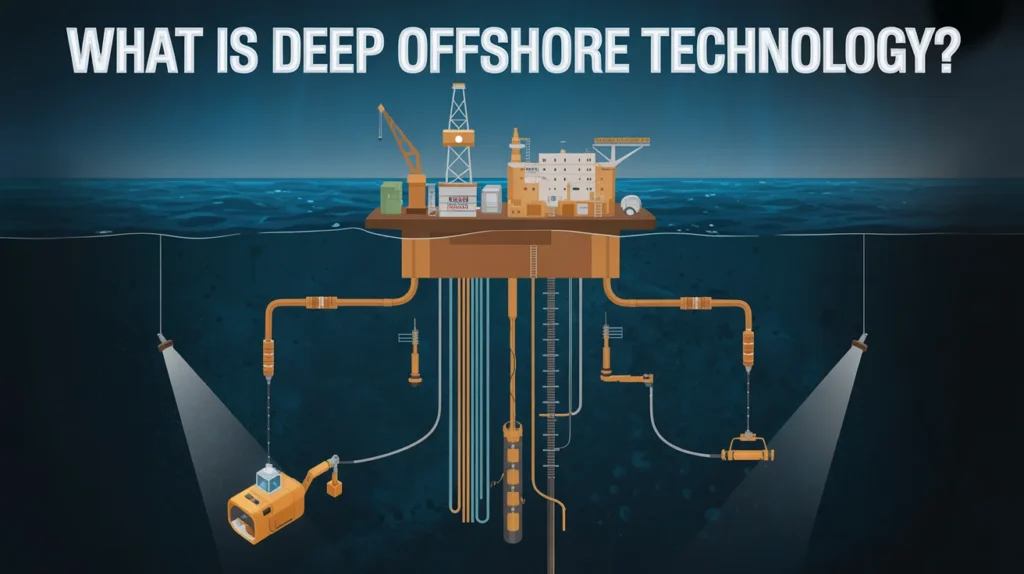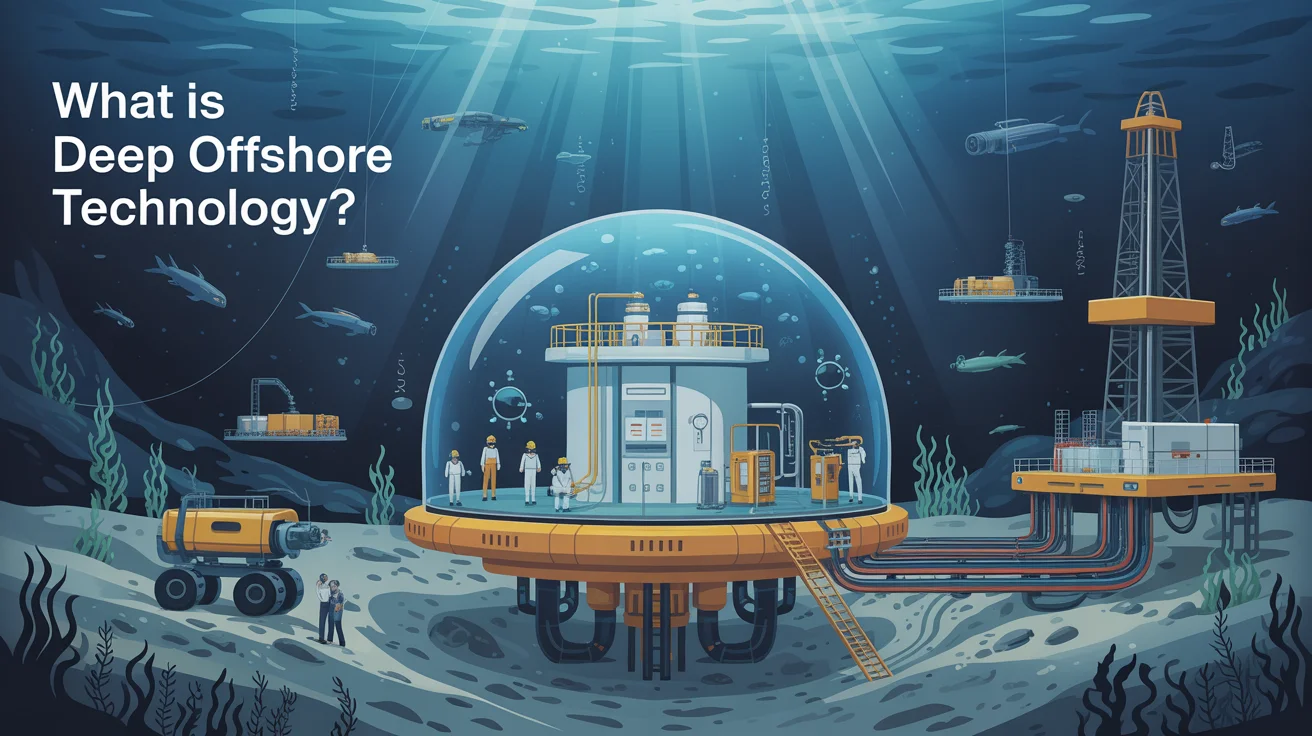Deep offshore technology refers to specialized systems and engineering innovations that explore and extract oil and gas from ocean depths, usually beyond 500 meters. These harsh environments require advanced tools to perform safely and efficiently under high pressure.
This technology has significantly impacted global energy production. As shallow reserves decline, deepwater resources are becoming essential. Through cutting-edge techniques, offshore industries are tapping into these new reserves.
Evolution and Importance of Offshore Innovation
Over time, deep offshore tech has transformed dramatically. From basic drilling tools, we now have AI-driven systems, robotic arms, and smart monitoring that push the limits of what’s possible in deep water.
This evolution matters because it meets growing global energy needs. It also drives engineering advancements, creates jobs, and helps coastal countries grow their economies through oil and gas exports.
Key Components of Deep Offshore Technology and Their Roles
Several vital components make deepwater operations possible. These tools ensure that oil and gas are extracted safely from beneath the ocean floor and brought to the surface efficiently. Their precision and durability are essential for successful offshore projects.
Essential Tools and Equipment
Here are some of the key systems used in deep offshore operations:
- Subsea trees: Control the flow of oil and gas from wells located on the seabed.
- Blowout preventers (BOPs): Prevent sudden pressure releases and accidents during drilling.
- Dynamic positioning systems: Keep floating rigs and vessels stable without anchors.
- FPSO units (Floating Production Storage and Offloading): Store oil before transferring it to tankers.
- AUVs (Autonomous Underwater Vehicles) – Perform inspections, maintenance, and data collection below the surface.
Challenges in Operating in Deep Waters
Working at extreme depths presents numerous challenges. The ocean floor is under immense pressure that can crush machinery that is not built for such environments. Additionally, the cold temperatures near the seabed can cause pipeline freezing and slow system performance.
Environmental safety is another concern. Any spill or equipment failure can damage sensitive marine ecosystems, making safety systems and environmental monitoring crucial to deep offshore operations.
Technological Advancements Making a Difference
To address these challenges, the industry has embraced innovative technologies. These systems boost efficiency and enhance safety and sustainability. One such advancement is digital twin technology, which allows engineers to simulate offshore operations before they even begin.
Another major shift is the use of artificial intelligence and machine learning. These technologies analyze vast amounts of data, helping predict potential problems and making operations more reliable and less risky.
New Innovations in Deep Offshore Tech
The following advancements are changing how offshore systems operate:
- Digital twin modelling: Creates real-time simulations of offshore platforms for testing and optimization.
- AI-powered sensors: Detect irregularities before they become failures.
- 3D printing: Allows on-demand production of spare parts for deepwater tools.
- Remote operation centres: Let engineers control offshore systems from land-based offices.
Environmental Sustainability in Offshore Technology

In recent years, sustainability has become a top priority in the offshore industry. Companies are investing in clean, energy-efficient systems that reduce their impact on the ocean and air. This shift ensures that energy production can continue without harming the environment.
Electrified subsea systems, for instance, replace hydraulic systems that can leak fluids. This reduces environmental hazards and improves long-term maintenance. Renewable power sources, such as offshore wind, are also being used to support these operations.
Eco-Friendly Innovations
Below are some methods used to make offshore technology more environmentally sustainable:
- Electric subsea systems: Use less harmful fluids and produce fewer emissions.
- Carbon capture and storage (CCS): Captures CO₂ and stores it underground, preventing air pollution.
- Smart discharge treatment: Filters waste before releasing it into the sea.
- Hybrid energy platforms: Combine oil extraction with wind or solar energy production.
Economic Impact of Deep Offshore Projects
Deep offshore exploration isn’t just about science but also business. These projects create thousands of jobs, build up local economies, and bring in billions in revenue for oil-producing nations. From Brazil to Norway, offshore drilling is a major contributor to national GDP.
Moreover, these sites have often produced oil for decades, providing long-term energy security and economic stability. As global demand rises, deepwater oil becomes even more important.
Safety Systems and Monitoring Tools
Safety is always a top concern in offshore drilling. Companies use automated systems to prevent blowouts, equipment failures, and environmental leaks. These systems are powered by real-time data and backed by smart algorithms that ensure quick action when something goes wrong.
Smart sensors monitor every part of the system, from wellheads to risers. These technologies improve decision-making and allow for remote control from safer onshore locations.
Future of Deep Offshore Exploration
The future of deep offshore exploration is exciting and full of potential. New technologies are being developed, allowing us to drill deeper, faster, and more safely than ever. Robotics, blockchain data systems, and renewable integration are paving the way.
The Arctic and ultra-deepwater zones are likely to be the next frontiers. As energy companies look beyond traditional sites, automation and AI will lead in reducing costs and improving outcomes.
Conclusion
Deep offshore technology has advanced greatly, enabling us to access valuable resources from under the sea. From smart drilling systems to eco-friendly subsea designs, it represents the future of energy extraction. As it evolves, this technology will continue to balance safety, efficiency, and sustainability, ensuring a stable energy future for all.
Frequently Asked Questions:
What is deep offshore technology used for?
It is used to drill and extract oil and gas from deep underwater locations.
How deep can offshore drilling go?
Modern technology allows drilling beyond 3000 meters underwater.
Is offshore oil production harmful to the environment?
When safety systems and eco-friendly tools are used, risks are significantly reduced.
What powers offshore platforms?
They can be powered by diesel, gas, and increasingly by wind or solar energy.
Are robots used in offshore drilling?
Autonomous underwater vehicles and robotic arms are common in inspections and repairs.




